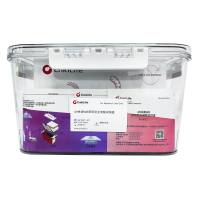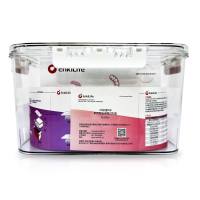Western blot实验步骤
互联网
1. Resolve sample proteins and controls via polyacrylamide gel electrophoresis. Transfer proteins to nitrocellulose using standard methods.
2. Remove the blot from the transfer apparatus and soak in TTBS (Tween-Tris Buffered Saline: 0.1% Tween-20 in 100 mM Tris-CL [pH 7.5], 0.9% NaCl) for two rinses of 15 min. each. The blot may be marked (with pencil or India Ink) for identification at this stage if desired.
3. Block the blot with 10% nonfat dried milk (NFDM) freshly made in TTBS; rock on a rotating shaker for 15 min. at room temperature or overnight at 4°C.
4. Rinse the blot 3 times in TTBS.
5. Probe with primary antibody in TTBS/1% NFDM for 1 hr. at room temperature. Primary antibody should be diluted as specified on product data sheets. If these values are not available, use the following guidelines for initial experiments: apply antisera or ascites at 1:500 to 1:5,000, apply purified primary antibodies at a concentration of 1 ug/ml.
6. Rinse the blot three times in TTBS.
7. Probe the blot with an enzyme-linked secondary antibody (typically horseradish peroxidase or alkaline phosphatase) in TTBS/1% NFDM for 30 min. at room temperature. Review instructions included with the secondary antibody to determine the appropriate dilution to use.
8. Rinse excess secondary antibody from the blot with 3 rinses in 20-50 ml TTBS for 5 min. each. The blot is now ready for use with standard colorimetric or chemiluminescent detection reagents.
Considerations:
• Perhaps the most common problem in western blotting is the occurrence of background staining. The best remedy for high background (in many cases) is simply to dilute the primary antibody further. Other solutions include ensuring that detergent is used in the blocking reagent, using an alternate blocking reagent (casamino acids, BSA, serum), and decreasing the amount of protein applied to the electrophoresis gel.
• Occurrences of extra bands in the blot can be resolved by several strategies. Run a control blot omitting the primary antibody to determine if the secondary antibody is the source of the problem. Replacing the secondary antibody with a different lot or a similar reagent from a different source can provide resolution. Spurious bands below the targeted molecular weight suggest that the protein is being degraded in the experiment; inclusion of protease inhibitors can help.
• No or low signal can be remedied by loading more protein in the gel or increasing the amount of primary and/or secondary antibody applied to the blot.
• Some antibodies will not bind in the presence of detergent; consult the datasheet for each antibody prior to performing any procedure.








